7 Ayurvedic Skincare Ingredients for Glowing Skin
Introduction
- Why Ayurveda is Making a Comeback in Skincare
- Ayurveda, India’s traditional system of holistic medicine, is regaining appeal in skincare as people seek natural and sustainable beauty solutions. Modern customers are growing more aware of the dangers of synthetic chemicals and choose solutions that encourage long-term skin health rather than providing quick remedies.
- Ayurvedic skincare ingredients focuses on balancing the body’s doshas (Vata, Pitta, and Kapha) to address the underlying causes of skin problems. Turmeric (anti-inflammatory), neem (anti-bacterial), and sandalwood (soothing) have been used for ages and are now finding their way into current formulas. Brands are mixing traditional components with scientific research to ensure efficacy and safety, hence increasing confidence.
- Social media and influencer marketing have also played an important role in this revival, with DIY cures, herbal routines, and Ayurvedic lifestyle suggestions becoming popular. Furthermore, the global push for wellness and self-care has transformed holistic skincare into a lifestyle choice rather than a beauty routine.
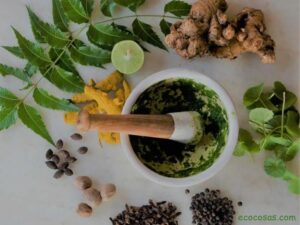
- Importance of Natural, Holistic Beauty Trends in 2025
- Beauty is going beyond appearance in 2025, with a focus on wellbeing, sustainability, and authenticity. Consumers are looking for solutions that are not only effective but also gentle on the skin, body, and environment. The clean beauty movement, which promotes plant-based, chemical-free, and environmentally friendly formulas, has gone popular.
- Holistic skincare trends prioritize rituals over routines. Practices like facial yoga, meditation, and herbal therapies are gaining popularity as they align with a more mindful approach to self-care. This mirrors Ayurvedic philosophy, which links skin health to overall lifestyle factors such as diet, sleep, and stress management.
- Transparency and sustainability will also define the beauty sector in 2025. Customers want to know how materials are sourced, if the items are cruelty-free, and if the packaging is environmentally friendly. Personalised skincare solutions—tailored to skin type, climate, and individual requirements—are becoming the norm.
- As consumers value inner wellbeing and conscientious decisions, natural and holistic beauty trends are expected to dominate, transforming skincare into a reflection of healthy living rather than a quick cosmetic solution.
Rose – The Hydrating Glow Booster

- Benefits of Rose for Skin
- Roses are more than just love symbols; they are also effective skincare elements that have been used for millennia in Ayurveda, Unani, and modern beauty techniques. Rose petals, rosewater, and rose essential oil include antioxidants, vitamins A, C, and E, as well as natural moisturizing components that soothe, nourish, and renew the skin.
- Rose provides profound hydration, which is one of its key benefits. Rose petals contain natural sugars and oils that trap moisture into the skin, keeping it from becoming dry and drab. Rosewater also helps to regulate the pH of the skin, which reduces irritation while leaving it soft and supple.
Rose’s anti-inflammatory characteristics can help to reduce redness, sunburn, and the appearance of acne scars. Its antioxidants attack free radicals, hence preventing premature aging. - Additionally, rose’s moderate astringent qualities tighten pores, tone the skin, and improve overall texture. This makes rose-based skincare appropriate for all skin types, including sensitive and acne-prone skin.
- How to Use Rose in Daily Skincare
- Incorporating rose into your everyday skincare routine is both simple and effective. Rosewater toner is one of the most straightforward ways to reap its benefits. Spritz it on your face after cleansing to quickly moisturize and rejuvenate your skin.
- For intense hydration, combine a few drops of rose essential oil with a carrier oil such as jojoba or almond and gently massage into your skin. This promotes elasticity and keeps your skin plump and radiant.
- Homemade rose face masks are another excellent choice. Combine rose petal powder with yogurt or honey to create a relaxing, brightening pack that leaves the skin feeling soft and beautiful.
- Rose-infused creams and serums provide excellent daily moisturization and anti-aging benefits. Select products containing natural rose extracts to ensure optimal strength and safety.
- For a luxurious experience, add a few drops of rose oil to your bath water. It soothes the senses and deeply nourishes the skin.
Rakta Chandan – The Brightening Herb
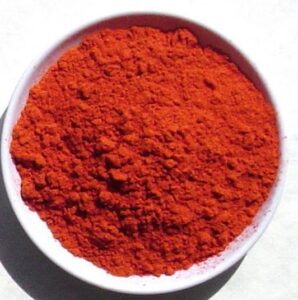
- Skin-Brightening & Anti-Inflammatory Properties
- Rakta Chandan, commonly known as Red Sandalwood, is a highly prized herb in Ayurvedic skincare due to its remarkable ability to improve skin tone and texture naturally. Unlike normal sandalwood (white), Rakta Chandan is valued for its powerful brightening, calming, and healing powers.
- Its principal benefit is skin lightening. Regular application helps to minimize pigmentation, black spots, and uneven skin tone, presenting a healthy shine. It gently exfoliates dead skin cells, stimulates cell regeneration, and improves overall complexion without creating irritation, making it suitable even for sensitive skin.
- Rakta Chandan is also recognized for its anti-inflammatory effects, which can alleviate acne, rashes, and minor skin irritations. It cools the skin and relieves redness and edema caused by heat or allergies. Its antioxidant component also defends against free radical damage, which helps to prevent the appearance of early aging indicators like fine wrinkles and dullness.
Because of these combined benefits, Rakta Chandan has become a popular ingredient in Ayurvedic face packs, washes, and serums aimed at providing a beautiful and even-toned complexion.
- Best Ways to Include Rakta Chandan in Face Packs
- Rakta Chandan can be readily included into your skincare routine via DIY face packs or pre-made Ayurvedic formulations.
- Make a smooth paste by mixing 1-2 teaspoons of Rakta Chandan powder with rose water.
Apply evenly to your face and leave for 15-20 minutes before rinsing.
This pack brightens dull skin and restores its natural glow. - Rakta Chandan & Honey Pack: Combine Rakta Chandan powder and organic honey to create a thick paste.
Apply to pigmented areas or the whole face for 20 minutes.
This combination moisturizes and reduces dark spots and imperfections. - Rakta Chandan & Aloe Vera Gel Pack: Combine Rakta Chandan with fresh aloe vera gel to create a cooling and comforting mask.
Manjistha – The Detoxifying Powerhouse
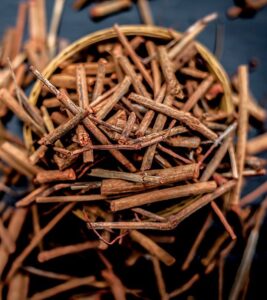
- Clears Blemishes & Purifies Blood
- Manjistha, also known as Indian Madder (Rubia cordifolia), has been a key component of Ayurvedic cosmetics for ages due to its great purifying effects. It is well-known for producing clear, bright skin by eliminating pollutants both internally and outwardly.
- One of its primary benefits is its capacity to purify blood, which has a direct impact on skin health. According to Ayurveda, impurities and poisons in the bloodstream cause various skin problems, including acne, pigmentation, and dullness. Manjistha acts as a natural cleanser, flushing out pollutants and improving circulation, resulting in a better complexion.
- Its anti-inflammatory and antibacterial characteristics make it an effective treatment for acne-prone skin. Manjistha is used on a regular basis to reduce redness, relieve irritation, and lessen the appearance of blemishes and scars. Furthermore, it contains antioxidants that fight free radicals, preventing premature aging and promoting general skin renewal.
Manjistha, whether taken as a supplement (under expert supervision) or applied topically in skincare formulas, is renowned for its ability to restore the skin’s natural radiance and vitality. - DIY Face Masks with Manjistha
- Manjistha is easily included into skincare routines with easy, effective DIY face masks:
- Manjistha and Yogurt Mask: Combine 1 teaspoon Manjistha powder with 2 teaspoons yogurt.
Apply to your face and leave on for 15-20 minutes.
This mask moisturizes the skin and reduces pigmentation and blemishes. - Manjistha and Honey Mask: Mix 1 teaspoon Manjistha powder with 1 teaspoon honey.
Apply evenly on skin for 15 minutes.
Reduces inflammation and promotes brightness. - Manjistha & Aloe Vera Gel Pack: Combine Manjistha powder and fresh aloe vera gel to create a cooling paste.
Suitable for acne-prone and sensitive skin.
Mulethi – The Spot & Tan Corrector
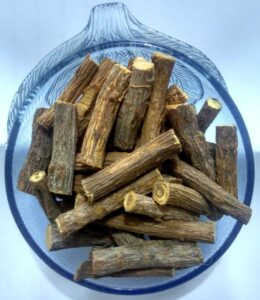
- Fades Pigmentation & Evens Skin Tone
- Mulethi, often called Licorice Root, is a potent Ayurvedic herb that is well-known for its ability to lighten and cure skin. Mulethi, which is abundant in glabridin, a natural substance that prevents the synthesis of melanin, is very good at minimizing pigmentation, sun spots, and uneven skin tone.
Its antioxidant and anti-inflammatory qualities reduce redness, calm irritated skin, and guard against free radical damage, which causes premature aging. Mulethi is a natural option for reducing tanning and reestablishing a healthy complexion because it also aids in the repair of UV damage. - Frequent application of mulethi in skincare improves the clarity of the skin, making it observably smoother, brighter, and more radiant. It also helps the skin’s natural healing process, which is advantageous for dark spots and scars brought on by acne or sun exposure.
- Face Packs & Serums Infused with Mulethi
- Simple DIY kits and pre-made serums make it simple to incorporate mulethi into everyday skincare:
- Milk Pack & Mulethi
o Combine two teaspoons of raw milk with one teaspoon of mulethi powder.
After 20 minutes, cleanse the skin after applying evenly.
o Perfect for balancing out skin tone and minimizing tan. - Mulethi & Honey Brightening Pack o Make a moisturizing and energizing mask by mixing organic honey with mulethi powder.
To boost glow and fade spots, apply for 15 minutes. - Serums Infused with Mulethi
Seek out serums that contain hyaluronic acid, vitamin C, and natural mulethi extract.
For long-term pigmentation control and brightening effects, apply twice a day.
Turmeric – The Golden Healer
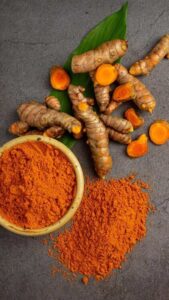
- Anti-Aging & Anti-Acne Benefits
- In Ayurveda, turmeric, also called “haldi,” is a highly valued herb that is praised for its anti-inflammatory, healing, and energizing qualities. Turmeric, which has been used for generations to support healthy, radiant skin, is rich in curcumin, a potent bioactive component.
- Its anti-aging qualities are one of its main advantages. In order to lessen wrinkles, fine lines, and loss of elasticity, turmeric fights free radicals that harm skin cells. Its antioxidants maintain the skin firm and young by increasing the formation of collagen.
- Turmeric is also a very good treatment for pimples and acne. Redness is lessened, breakouts are lessened, and more skin irritation is avoided because to its antibacterial and anti-inflammatory qualities. Additionally, it helps to improve complexion overall and fade acne scars.
- In addition to improving brightness, regular application of turmeric in skincare products fortifies the skin’s natural barrier, shielding it from environmental aggressors and early.
- Best DIY Turmeric Masks for Radiant Skin
- DIY face masks that are straightforward but effective can use turmeric with ease:
- Yogurt & Turmeric Glow Mask: Combine 2 teaspoons yogurt and 1 teaspoon turmeric.
Let it sit on the face for fifteen minutes before washing it off.
Hydrates skin while boosting its inherent radiance. - Acne Mask with Turmeric and Honey: Mix 1 teaspoon each of turmeric and honey.
For ten to fifteen minutes, apply to the impacted regions.
· Lessens scarring and aids in combating bacteria that cause acne. - Turmeric & Gram Flour Brightening Pack o Make a paste by combining turmeric, milk, and gram flour (besan).
To improve skin tone and get rid of tans, use it as an exfoliating mask.
Neem – The Natural Skin Purifier
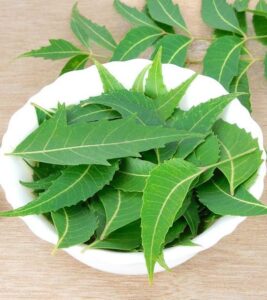
- In Ayurveda, neem is frequently referred to as the “miracle herb” and is one of the most effective natural treatments for skin prone to acne. Packed with antibacterial, antifungal, and anti-inflammatory qualities, neem helps combat bacteria that cause acne, minimizes excess oil, and stops outbreaks from happening again.
Its high antioxidant and fatty acid content also aids in skin restoration and acne scar fading, leaving the complexion smoother and clearer. Neem is perfect for sensitive and irritated skin because of its cooling properties, which reduce redness and inflammation.
By preserving a healthy and balanced skin environment, regular neem application not only treats current pimples but also helps avoid new ones. Because of its purifying properties, pollutants are eliminated, leaving skin feeling renewed and healthy.
- Neem Packs & Toners for Clear Skin
- Neem can be added to a variety of skincare products to give you beautiful, acne-free skin. Here are a few efficient methods:
- Pack of Neem and Multani Mitti o Combine neem powder, Fuller’s Earth (multani mitti), and rose water.
o To reduce oil, unclog pores, and avoid pimples, apply for 15 to 20 minutes. - Neem & Turmeric Pack o Make a potent antibacterial face mask by mixing neem paste with turmeric.
o Naturally lowers inflammation and aids in the treatment of aggressive acne. - Neem Toner: To create a natural toner, boil fresh neem leaves in water, let them cool, and then filter them.
o To keep skin clear and avoid outbreaks, spray every day after cleansing.
Aloe Vera – The Soothing Hydrator
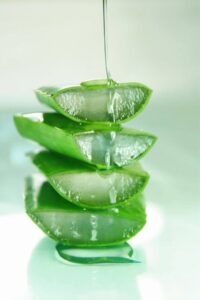
- Repairs Skin Barrier & Locks in Moisture
- For generations, aloe vera, also referred to as the “plant of immortality,” has been a mainstay of natural skincare because of its remarkable moisturizing and healing qualities. Packed with antioxidants, enzymes, amino acids, and vitamins A, C, and E, it supports general skin renewal and repair while nourishing the skin.
- The capacity of aloe vera to strengthen a compromised skin barrier is one of its most notable advantages. Dryness, irritation, and early aging can result from this barrier being weakened by daily exposure to pollutants, inclement weather, and chemical-based products. Aloe Vera functions by providing deep hydration and nutrients that strengthen resilience and restore the integrity of the skin.
- The inherent humectant properties of aloe vera also draw and retain moisture in the skin. This maintains it hydrated, plump, and soft all day long without clogging pores, making it perfect for all skin types, including those with oily or acne-prone skin. Because of its calming and cooling qualities, it’s also a great treatment for inflammation, redness, and sunburns.
- Aloe-Based Gels & Masks for Daily Use
- You can incorporate aloe vera into your everyday regimen by using premade skincare products or easy do-it-yourself treatments:
- Pure Aloe Vera Gel: As a light moisturizer, apply fresh aloe vera gel straight to cleansed skin.
All-day hydration and irritation relief are two benefits. - Aloe Vera & Honey Mask: For intense nutrition, mix organic honey with aloe vera gel.
o To cure dryness and restore radiance, leave on for 20 minutes. - Aloe Vera & Cucumber Cooling Mask: For a revitalizing pack, mix aloe vera gel with cucumber juice.
o Perfect for soothing irritated or sun-exposed skin. - Aloe-Based Lotions & Serums
For extra moisture and brightness, use products that contain aloe vera along with complimentary nutrients like vitamin C or hyaluronic acid.
Conclusion: Ayurvedic Skincare – The Path to Glowing Skin in 2025
- Ayurveda has endured because it provides comprehensive remedies that go beyond aesthetics. Ayurvedic elements are experiencing a significant resurgence in 2025 as customers look for skincare products that are genuine, natural, and effective. In addition to addressing certain issues like hydration, brightness, detoxification, and acne prevention, herbs like rose, rakta chandan, manjistha, mulethi, turmeric, neem, and aloe vera help nourish skin from the inside out for long-lasting effects.
- Each of these herbs has special advantages.
- Rose imparts a gentle, dewy glow and moisturizes.
- Manjistha cleanses and removes imperfections, while Rakta Chandan evens and brightens skin tone.
- Mulethi corrects tanning and fades pigmentation.
- Turmeric slows down aging, reduces acne, and promotes healing.
- Neem cleanses and guards against acne.
- Aloe Vera thoroughly moisturizes, calms, and restores.
- The holistic approach of Ayurvedic skincare is what really sets it apart. It aims to organically improve skin health, balance the body, and soothe the mind rather than cover up issues. Ayurveda provides the ideal fusion of traditional knowledge and contemporary research to satisfy the skincare demands of the modern world, especially in light of the expanding trends toward clean beauty, sustainability, and wellbeing.
Your Turn to Glow Naturally
- Take advantage of nature’s medication now to see the difference for yourself. Start slowly and observe how your skin reacts by using a neem face pack, a turmeric mask, or a rose toner.
- Glowing skin starts with natural care, so try Ayurvedic skincarefrim www.nainsherbal.com now and let us know how it goes!
FAQs
What are Ayurvedic skincare ingredients?
Ayurvedic skincare ingredients are natural herbs, roots, flowers, and oils used in traditional Indian skincare to promote healthy, glowing skin.
Which Ayurvedic herbs are best for glowing skin?
Turmeric, Aloe Vera, Neem, Sandalwood, Tulsi, Rose, and Saffron are highly recommended for radiant skin.
How does Ayurveda help in improving skin texture?
Ayurveda balances the body’s doshas (Vata, Pitta, Kapha) and uses herbal remedies to nourish and rejuvenate skin from within.
Can Ayurvedic skincare replace chemical products?
Yes, Ayurvedic skincare can serve as a natural alternative to chemical-based products, providing long-term benefits without harsh effects.
Is Ayurvedic skincare suitable for sensitive skin?
Most Ayurvedic ingredients are gentle, but patch testing is recommended, especially for sensitive or allergy-prone skin.
What Ayurvedic ingredient is best for pigmentation?
Turmeric and Saffron are excellent for reducing pigmentation and brightening skin tone naturally.
Can Ayurvedic remedies help with acne and scars?
Neem, Tulsi, and Aloe Vera are highly effective in controlling acne, reducing inflammation, and fading scars.
How to Change my Photo from Admin Dashboard?
Face packs can be used 2-3 times a week depending on your skin type and specific ingredients used.
Are Ayurvedic skincare results long-lasting?
Yes, with regular use and a balanced lifestyle, Ayurvedic skincare offers sustainable and long-lasting results.
Can I combine Ayurvedic and modern skincare products?
Yes, you can combine both, but introduce products gradually and ensure compatibility to avoid skin irritation.
